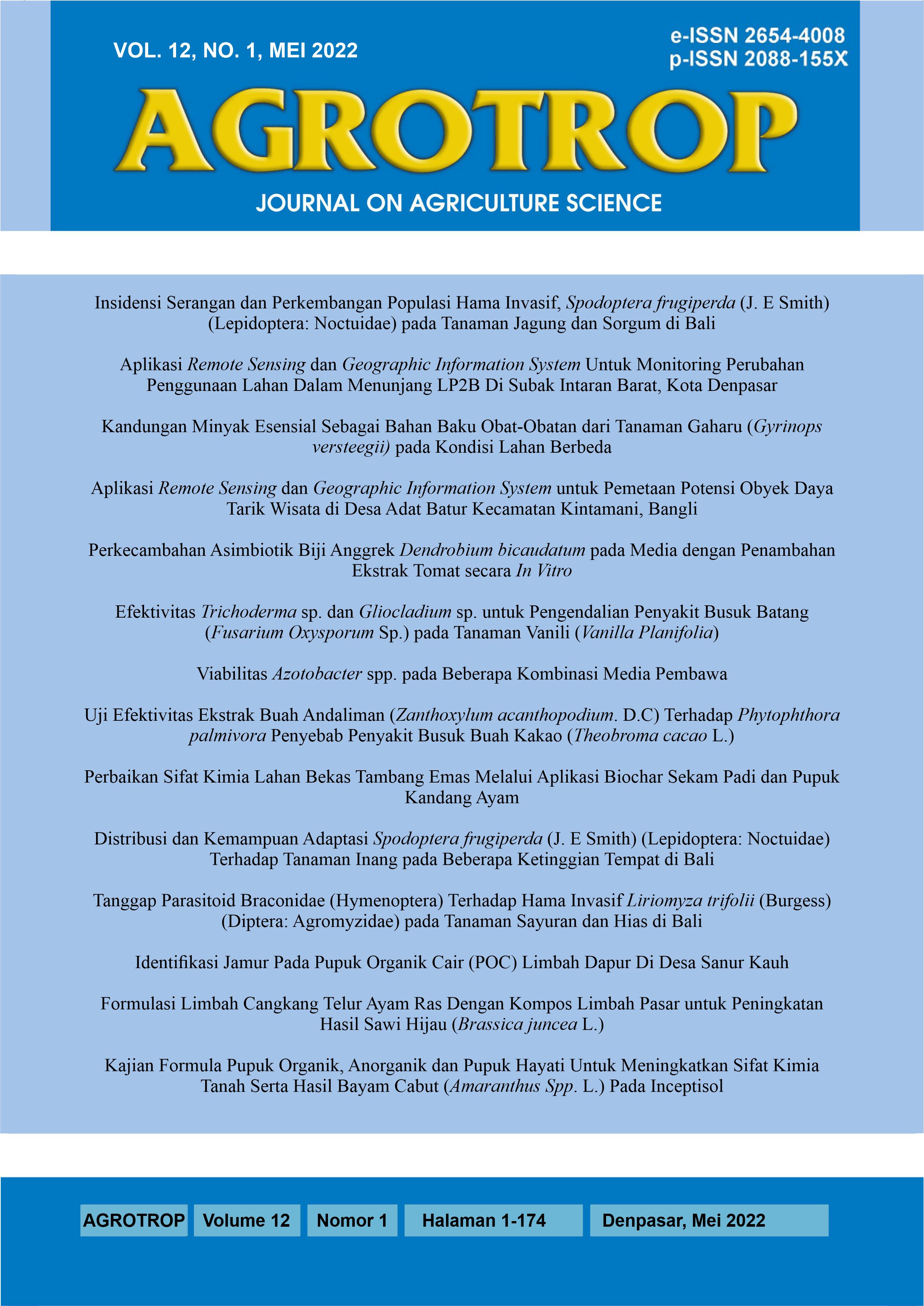Identifikasi Jamur Pada Pupuk Organik Cair (POC) Limbah Dapur Di Desa Sanur Kauh
Abstract
Identification of Fungi in Kitchen Waste Liquid Organic Fertilizer (LOF) in Sanur Kauh Village. Decomposed kitchen waste contains certain microorganisms, one of which is fungus. Fungi are one of the microorganisms that are widespread in soil and water and have the potential in the process of decomposition of organic matter. The research objective was to determine the composition of kitchen waste and obtain fungi species from LOF of kitchen waste in Sanur Kauh Village. The research was conducted from September to December 2020. Sampling was conducted in Sanur Kauh Village, South Denpasar District. Furthermore, LOF making and analysis was carried out at the Laboratory of Soil and Environmental Sciences, Faculty of Agriculture, Udayana University and at the Indonesian Genetika Science Laboratory, Tangerang. The method used is a descriptive analysis experiment, which consists of field exploration, laboratory analysis and molecular identification. The results showed that the most dominant percentage of LOF from kitchen waste composition was fruit at 46.69% followed by vegetables at 24.17%, rice at 18.92%, egg shells, bones and meat at 5.16% and the remaining side dishes of 5.06%. The results of molecular identification of fungal species on LOF fermentation of kitchen waste isolates LDA 2 and LDB 2 were similar to Pichia kudriavzevii strain CBS5174 chromosome 2 (99.71%) and Pichia kudriavzevii culture CBS: 5147 (99.56%).
Downloads
References
Brinkman, F. S. L and Leipe D. D. 2001. Phylogenetic Analysis. In: Bioinformatics: A Practical Guide to the Analysis of Gene and Protein. Baxevanis, A. D. and B. F. F. Ouellette (Eds.). John Willey & Sons. pp. 323-358.
Budiyani, N. K., N. N. Soniari, N. W. S. Sutari, 2016. Analisis Kualitas Larutan Mikroorganisme Lokal (MOL) Bonggol Pisang. Jurnal Agroekoteknologi Tropika, 5(1): 63-72. ISSN: 2301-6515.
Chan, G.F., Gan, H.M., Ling H.L., Rashid N.A. 2012. Genome Sequence of Pichia kudriavzevii M12, a Potensial Producer of Bioethanol and Phytase. Eukaryot Cell. 11(10).
Citra, Y. I. F. 2019. Isolasi dan Identifikasi Khamir pada Bunga Pisang Klutuk(Musa balbisiana) serta Kemampuannya dalam fermentasi Karbohidrat. Skripsi. Jurusan Biologi, Fakultas Sains dan Teknologi, Universitas Islam Negeri Maulana Malik Ibrahim, Malang.
Haddad, R., Alemzadeh, E., Ahmadi, A.R., Hosseini, R., & Moezzi, M. 2014. Identification of Chlorophyceae based on 18S rDNA Sequences from Persian Gulf. Iranian Journal of Microbiology. 6(6): 437.
Hadisuwito, S. 2012. Membuat Pupuk Organik Cair. PT. Agro Media Pustaka. Jakarta.
Herlanda, R. 2017. Eksplorasi dan Uji Potensi Khamir sebagai Pendegradasi Residu Fungisida Berbahan Aktif Propineb secara in vitro. Skripsi. Program Studi Agroekoteknologi, Fakultas Pertanian, Universitas Brawijaya.
Indrawati, I. dan S. D. Fakhrudin. 2016. Isolasi dan Identifikasi Jamur Patogen pada Air Sumur dan Air Sungai di Pemukiman Warga Desa Karangwangi, Cianjur, Jawa Barat. Jurnal Biodjati Vol 1 (1): 27-38
Katsu, M., S. Kidd, A. Ando, M.L. Moretti-Branchini, Y. Mikami, K. Nishimura & W. Meyer. 2003. The Internal Transribed Spacers and 5.8S rRNA Gen Show Extensive Diversity among Isolates of the Cryptococcus neformans Species Complex. FEMS Yeast Res. 1608: 1-12.
Krisnaningsih, A. dan Suhartini. 2018. Kualitas dan Efektivitas POC dari MOL Limbah Buah-buahan Terhadap Pertumbuhan dan Produksi Tanaman Sawi. Jurnal Prodi Biologi. Vol. 7 No. 6. Yogyakarta.
Meryandini, A., Basri, A., Sunarti, T.C. 2019. Peningkatan Kualitas Biji Kakao (Theobroma cacao L) melalui Fermentasi Menggunakan Lactobacillus sp. dan Pichia kudriavzevii. Jurnal Bioteknologi & Biosains Indonesia. 6(1): 11-19 ISSN: 2548-611X
Mokodompis, D. 2018. Efektivitas Mikroorganisme Lokal MOL Limbah Sayuran dan Buah- Buahan sebagai Aktifator Pembutan Kompos. Fakultas Kesehatan Masyarakat, Universitas Muhammadiyah Palu.
Salma, S. dan L. Gunarto. 1999. Enzim Selulase Dari Trichoderma sp. Balai Penelitian Bioteknologi Tanaman Pangan. Bogor. Jurnal Tinjauan Ilmiah Riset Biologi dan Bioteknologi Pertanian. 2(2): 37-38.
Stackebrandt, E., Goebel, B. M. 1994. Taxonomic Note: A Place for DNA-DNA Reassociation and 16S rRNA Sequence Analysis in the Present Species Definition in Bacteriology. International Journal of Systematic and Evolutionary Microbilogy. 44: 846-849.
Sugita, T., Nishikawa, A., Ikeda, R., & Shinoda, T. 1999. Identification of Medically Relevant Trichosporon species based on Sequences of Internal Transcribed Spacer Regions and Construction of a Database for Trichosporon Identification. Journal of Clinical Microbiology. 37(6) : 1985-1993.
White, T. J, T. Bruns, S. Lee and J. Taylor. 1990. PCR Protocols: Aguide to Methods and Applications (Amplification and Direct Sequencing of Fungal Ribosomal RNA Genes for Phylogenetics). Academic Press Part Three Genetic and Evolution. PP. 315-322.
Widayat et al., 2019. Real Time-Polymerase Chain Reaction (RT-PCR) sebagai Alat Deteksi DNA Babi dalam Beberapa Produk Non-Pangan. Indonesian Journal of Halal. ISSN : 2656-4963.











